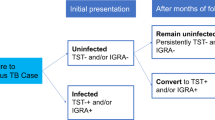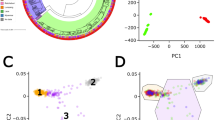Abstract
Tuberculosis remains a significant global health problem: one-third of the human population is infected with Mycobacterium tuberculosis (MTB) and 10% of those are at lifetime risk of developing tuberculosis. In the majority of individuals infected, genetic determinants of susceptibility remain largely unknown due to complex multigenic control and the influence of genes—environment interactions. Genetic variation of host resistance to MTB in animal models reflects heterogeneity among humans. Stepwise dissection of these interactions will permit the deciphering of MTB's complex virulence strategy. Previously, we have characterized a mouse supersusceptibility locus (sst1) controlling antituberculosis immunity. In this study, eight host resistance quantitative trait loci (QTLs) were mapped that counter-balance the devastating effect of sst1, among which a QTL on chromosome 7 (Chr7) was most prominent. The Chr7 and sst1 loci independently control distinct resistance mechanisms to MTB, but their effects apparently converge on macrophages in remarkable synergy. Combining these resistance alleles on a C3HeB/FeJ-susceptible background reduced the lung pathology and improved survival after MTB challenge accounting for half of the difference between susceptible and resistant parental strains. These data reveal novel gene interactions controlling MTB resistance and will enable the identification of resistance gene(s) encoded within Chr7 locus.
This is a preview of subscription content, access via your institution
Access options
Subscribe to this journal
Receive 6 digital issues and online access to articles
$119.00 per year
only $19.83 per issue
Buy this article
- Purchase on Springer Link
- Instant access to full article PDF
Prices may be subject to local taxes which are calculated during checkout




Similar content being viewed by others
Abbreviations
- Chr7:
-
chromosome 7 locus
- Ipr1:
-
intracellular pathogen resistance protein 1
- MTB:
-
Mycobacterium tuberculosis
- QTL:
-
quantitative trait locus
- sst1 :
-
super susceptibility to tuberculosis 1
References
WHO. Global tuberculosis control—surveillance, planning, financing. WHO Report 2006.
Schurr E . Is susceptibility to tuberculosis acquired or inherited? J Intern Med 2007; 261: 106–111.
Britton WJ, Fernando SL, Saunders BM, Sluyter R, Wiley JS . The genetic control of susceptibility to Mycobacterium tuberculosis. Novartis Found Symp 2007; 281: 79–89; discussion 89–92, 208–209.
Hill AV . Aspects of genetic susceptibility to human infectious diseases. Annu Rev Genet 2006; 40: 469–486.
Hill AV . The genomics and genetics of human infectious disease susceptibility. Annu Rev Genomics Hum Genet 2001; 2: 373–400.
Buschman E, Apt AS, Nickonenko BV, Moroz AM, Averbakh MH, Skamene E . Genetic aspects of innate resistance and acquired immunity to mycobacteria in inbred mice. Springer Semin Immunopathol 1988; 10: 319–336.
Lurie MB, Zappasodi P, Dannenberg Jr AM, Weiss GH . On the mechanism of genetic resistance to tuberculosis and its mode of inheritance. American Journal of Human Genetics 1952; 4: 302–314.
Lynch CJ, Pierce-Chase CH, Dubos R . A genetic study of susceptibility to experimental tuberculosis in mice infected with mammalian tubercle bacilli. J Exp Med 1965; 121: 1051–1070.
Medina E, North RJ . Genetically susceptible mice remain proportionally more susceptible to tuberculosis after vaccination. Immunology 1999; 96: 16–21.
Ulrichs T, Kaufmann SH . New insights into the function of granulomas in human tuberculosis. J Pathol 2006; 208: 261–269.
Fortin A, Abel L, Casanova JL, Gros P . Host genetics of mycobacterial diseases in mice and men: forward genetic studies of BCG-osis and tuberculosis. Annu Rev Genomics Hum Genet 2007; 8: 163–192.
North RJ, Jung YJ . Immunity to tuberculosis. Annu Rev Immunol 2004; 22: 599–623.
Sanchez F, Radaeva TV, Nikonenko BV, Persson AS, Sengul S, Schalling M et al. Multigenic control of disease severity after virulent Mycobacterium tuberculosis infection in mice. Infect Immun 2003; 71: 126–131.
Kramnik I, Demant P, Bloom BB . Susceptibility to tuberculosis as a complex genetic trait: analysis using recombinant congenic strains of mice. Novartis Found Symp 1998; 217: 120–131; discussion 32–37.
Lavebratt C, Apt AS, Nikonenko BV, Schalling M, Schurr E . Severity of tuberculosis in mice is linked to distal chromosome 3 and proximal chromosome 9. J Infect Dis 1999; 180: 150–155.
Mitsos LM, Cardon LR, Fortin A, Ryan L, LaCourse R, North RJ et al. Genetic control of susceptibility to infection with Mycobacterium tuberculosis in mice. Genes Immun 2000; 1: 467–477.
Mitsos LM, Cardon LR, Ryan L, LaCourse R, North RJ, Gros P . Susceptibility to tuberculosis: a locus on mouse chromosome 19 (Trl-4) regulates Mycobacterium tuberculosis replication in the lungs. Proc Natl Acad Sci USA 2003; 100: 6610–6615.
Yan BS, Kirby A, Shebzukhov YV, Daly MJ, Kramnik I . Genetic architecture of tuberculosis resistance in a mouse model of infection. Genes Immun 2006; 7: 201–210.
Kramnik I, Dietrich WF, Demant P, Bloom BR . Genetic control of resistance to experimental infection with virulent Mycobacterium tuberculosis. Proc Natl Acad Sci USA 2000; 97: 8560–8565.
Yan BS, Pichugin AV, Jobe O, Helming L, Eruslanov EB, Gutierrez-Pabello JA et al. Progression of pulmonary tuberculosis and efficiency of bacillus Calmette-Guerin vaccination are genetically controlled via a common sst1-mediated mechanism of innate immunity. J Immunol 2007; 179: 6919–6932.
Pan H, Yan BS, Rojas M, Shebzukhov YV, Zhou H, Kobzik L et al. Ipr1 gene mediates innate immunity to tuberculosis. Nature 2005; 434: 767–772.
Flint J, Valdar W, Shifman S, Mott R . Strategies for mapping and cloning quantitative trait genes in rodents. Nat Rev Genet 2005; 6: 271–286.
Boyartchuk VL, Broman KW, Mosher RE, D'Orazio SE, Starnbach MN, Dietrich WF . Multigenic control of Listeria monocytogenes susceptibility in mice. Nat Genet 2001; 27: 259–260.
Vidal SM, Malo D, Marquis JF, Gros P . Forward genetic dissection of immunity to infection in the mouse. Annu Rev Immunol 2008; 26: 81–132.
Wakeland E, Morel L, Achey K, Yui M, Longmate J . Speed congenics: a classic technique in the fast lane (relatively speaking). Immunol Today 1997; 18: 472–477.
Krog HH, Moutier R . Identification of inbred strains of mice: II. Characterization of different substrains of the C3H strain. J Hered 1978; 69: 66–70.
Kamath AB, Alt J, Debbabi H, Taylor C, Behar SM . The major histocompatibility complex haplotype affects T-cell recognition of mycobacterial antigens but not resistance to Mycobacterium tuberculosis in C3H mice. Infect Immun 2004; 72: 6790–6798.
Chackerian AA, Behar SM . Susceptibility to Mycobacterium tuberculosis: lessons from inbred strains of mice. Tuberculosis (Edinb) 2003; 83: 279–285.
Cervino A, Lakiss S, Sow O, Bellamy R, Beyers N, Hoal-van Helden E et al. Fine mapping of a putative tuberculosis-susceptibility locus on chromosome 15q11–13 in African families. Hum Mol Genet 2002; 14: 1599–1603.
Scheffner M, Huibregtse JM, Vierstra RD, Howley PM . The HPV-16 E6 and E6-AP complex functions as a ubiquitin-protein ligase in the ubiquitination of p53. Cell 1993; 3: 495–505.
Symons RC, Daly MJ, Fridlyand J, Speed TP, Cook WD, Gerondakis S et al. Multiple genetic loci modify susceptibility to plasmacytoma-related morbidity in E(mu)-v-abl transgenic mice. Proc Natl Acad Sci USA 2002; 99: 11299–11304.
Acknowledgements
We thank Drs Edward Jarroll and Angele Nalbandian for critical reading of this paper.
Author information
Authors and Affiliations
Corresponding author
Rights and permissions
About this article
Cite this article
Sissons, J., Yan, BS., Pichugin, A. et al. Multigenic control of tuberculosis resistance: analysis of a QTL on mouse chromosome 7 and its synergism with sst1. Genes Immun 10, 37–46 (2009). https://doi.org/10.1038/gene.2008.68
Received:
Revised:
Accepted:
Published:
Issue Date:
DOI: https://doi.org/10.1038/gene.2008.68
Keywords
This article is cited by
-
Mouse models of human TB pathology: roles in the analysis of necrosis and the development of host-directed therapies
Seminars in Immunopathology (2016)
-
The spectrum of latent tuberculosis: rethinking the biology and intervention strategies
Nature Reviews Microbiology (2009)
-
Lazy, Dynamic or Minimally Recrudescent? On the Elusive Nature and Location of the Mycobacterium Responsible for Latent Tuberculosis
Infection (2009)



